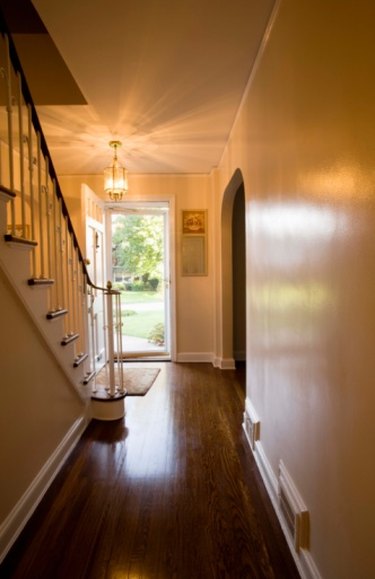Things You'll Need
Straight edge
2-inch finish nails
Drill
Hammer
Nail punch
Table saw
Floor nailer
2-inch cleats

Not all the rooms in your house receive the same amount of light, and a floor that looks good in one room may not look as good in another. Since most hardwood flooring boards have tongue-and-groove construction, it's not a difficult job to create a transition from one type of wood to another when laying a floor in an entire house. You can easily make transitions even if the boards have different widths, but it's not as easy if the boards have different thicknesses. If they do, you'll probably have to install transition strips where they meet.
Step 1
Make transitions in the entry doorways of individual rooms. To make a transition between a hallway and a large room, such as a living room, that doesn't have a doorway, line it up with the walls that frame the entry.
Video of the Day
Step 2
Start installing the flooring in your house by laying the first course at the most prominent transition. For example, if you are laying one type of hardwood in the living room and want to transition to a different hardwood in a hallway, draw a line with a straight edge between the walls framing the entrance to the living room and lay the first course of flooring for the living room or hallway along that line.
Step 3
Top-nail this first course of flooring. Drill pairs of pilot holes at 16-inch intervals with a 2-inch finish nail from which you have clipped off the head. Drive a 2-inch finish nail into each hole and set the head 1/8 to 1/4 inch deep with a nail punch.
Step 4
Cut a makeshift tongue from a spare piece of flooring on a table saw to stuff into the groove on the transition course. It should fit snugly in the groove and extend out at least 1/8 inch.
Step 5
Install one type of hardwood on one side of the transition, and the other type on the other side. Tap boards together and nail them with a flooring nailer, working first in one direction away from the transition and then in the other direction.
Step 6
Make a transition in a doorway by installing the floor outside the doorway until you have finished the course that extends into the doorjamb.
Step 7
Continue installing flooring inside the bedroom, but use a different hardwood of your choosing. Don't rip the last course of the flooring you use outside the room in order to make the transition fall exactly in the middle of the jamb. It is better to keep the boards intact and have the transition be slightly offset from the center.
Step 8
Cut the tongue off a transition board only if the hardwood you are transitioning into has a different thickness. Butt the groove side of the next course against the tongueless edge of the transition course and top-nail the boards in both courses. After the floor has been sanded and finished, nail a transition strip over the transition to prevent tripping.
Tip
You can run flooring perpendicularly in a room from a transition in a doorway. Fit the tongue ends of the flooring in the room into the groove of the transition board in the doorway. If the floorings have different thicknesses, though, you will have to cut the tongues off the ends of the boards at the transition and top-nail all of them. This may be unsightly.
Video of the Day